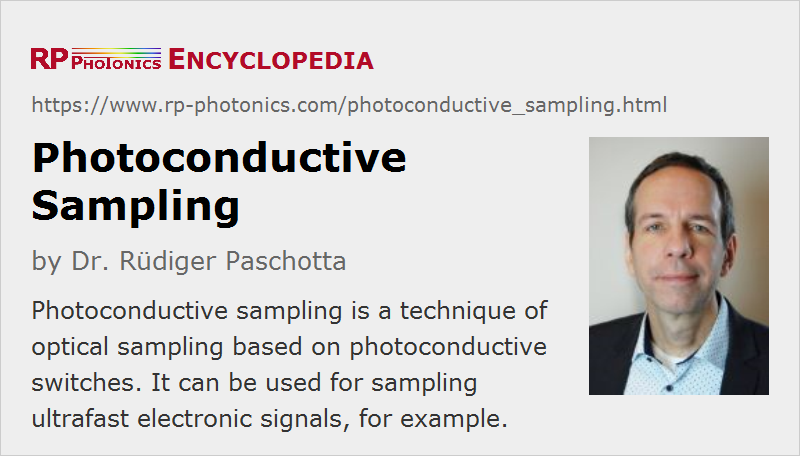Photoconductive Sampling
Definition: a technique of optical sampling with photoconductive switches
Categories:  optoelectronics,
optoelectronics,  methods
methods
Author: Dr. Rüdiger Paschotta
Cite the article using its DOI: https://doi.org/10.61835/1bb
Get citation code: Endnote (RIS) BibTex plain textHTML
Photoconductive sampling is a technique of optical sampling, based on the use of photoconductive switches. On such a switch, an ultrashort laser pulse can close an electrical connection for a very short time. A second photoconductive switch (driven with a delayed laser pulse) may be used for sampling of the resulting signal at a different location: the switch connects the corresponding part of the circuit with some output lead only for a very short time interval, the temporal position of which can be adjusted via an optical delay line.
An alternative sampling technique is electro-optic sampling. Compared with that, photoconductive sampling has the main advantages of allowing the generation of signals with higher frequencies (even without very fast electrical connections) and operating with higher spatial resolution, but it usually requires the fabrication of photoconductive switches at the test points (even though free-moving external probes have been demonstrated) and cannot be used for measuring electric fields outside conductors.
More to Learn
Encyclopedia articles:
Bibliography
| [1] | J. R. Andrews and R. A. Lawton, “Electrically strobed optical waveform sampling oscilloscope”, Rev. Sci. Instrum. 47 (3), 311 (1976); https://doi.org/10.1063/1.1134611 |
| [2] | F. W. Smith et al., “Picosecond GaAs-based photoconductive optoelectronic detectors”, Appl. Phys. Lett. 54 (10), 890 (1989); https://doi.org/10.1063/1.100800 |
| [3] | C. H. Lee, “Picosecond optics and microwave technology”, IEEE Trans. Microwave Theory Technol. 38 (5), 596 (1990); https://doi.org/10.1109/22.54928 |
Questions and Comments from Users
Here you can submit questions and comments. As far as they get accepted by the author, they will appear above this paragraph together with the author’s answer. The author will decide on acceptance based on certain criteria. Essentially, the issue must be of sufficiently broad interest.
Please do not enter personal data here; we would otherwise delete it soon. (See also our privacy declaration.) If you wish to receive personal feedback or consultancy from the author, please contact him, e.g. via e-mail.
By submitting the information, you give your consent to the potential publication of your inputs on our website according to our rules. (If you later retract your consent, we will delete those inputs.) As your inputs are first reviewed by the author, they may be published with some delay.


Share this with your friends and colleagues, e.g. via social media:
These sharing buttons are implemented in a privacy-friendly way!